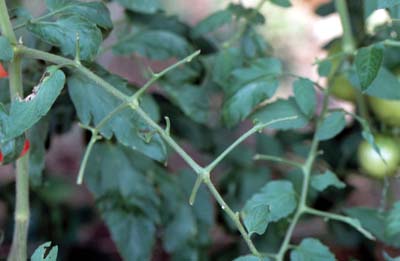
Defoliation of a tomato leaflet caused by tobacco hornworm,
Manduca sexta.
(Photographer: J. Castner, University of Florida)
The host range consists of only solanaceous (tomato and its relatives) plants, most commonly tomato and tobacco. Many solanaceous weeds serve as alternate hosts. Insecticides may be used to manage the pest population, but large larvae are difficult to kill. Bacillus thuringiensis may also be used to control the larvae. Cultural control practices include deep tillage to disturb diapausing pupae. Hand picking and destroying the larvae is a practical control method in a small garden. Polistes wasps are good predators of hornworms but may not provide adequate control due to the ability of the larvae to cause a large amount of damage in a short time. Management recommendations are the same for both species.
Images
To save the Web-optimized images shown below to your hard drive:
|
Click to access Display and Print quality images. |
|
Click to access Display and Print quality images. |
|
Click to access Display and Print quality images. |
|
Click to access Display and Print quality images. |
|
Click to access Display and Print quality images. |
|
Click to access Display and Print quality images. |
|
Click to access Display and Print quality images. |
|
Click to access Display and Print quality images. |